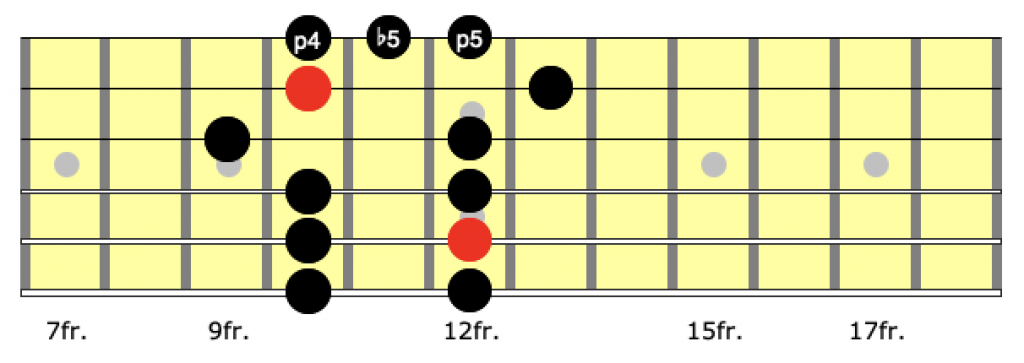How To Play The Blues Scale on Guitar
The blues scale is great for not only blues, but also pop, rock and metal lead guitar playing. Today, we’ll look at what the blues scale is,how you can use it in your guitar playing, and a few licks you can play to give the scale a go.
What is the Blues Scale?
The blues scale is a modified minor pentatonic scale. The minor pentatonic scale has the following intervals:
1 b3 4 5 b7
To create the blues scale, we add a b5 to the minor pentatonic scale:
1 b3 4 b5 5 b7
The b5 is sometimes referred to as the “blues note”.
Next, let’s look at how we play the blues scale:
Playing the Blues Scale on Guitar
To play the blues scale, we simply add the b5 to the minor pentatonic scale.
So, let’s look at the 5 positions of the minor pentatonic scale, and add in the “blues note”, to create the blues scale:
Position 1
Starting with the first position of the minor pentatonic scale, we want to identify the notes that are the 4 and 5:

And we then add the b5 to the scale:

To create the 1st position of the blues scale.
You might notice, that the minor pentatonic scale has the 4 and 5 occur a second time:

And we could add a second blues note into this position:

However, for the moment, we are only going to add one blues note to the first position. When we look at the other positions of this scale, we will find that they each have a blues note that fits.
So, we will leave the first position of the blues scale as follows:

As a final note on position 1, when you are playing and improvising - you can play these scales however you want.
For the remaining positions of the blues scale on guitar, we will follow the same process of identifying the p4 and p5 interval on the same string, and inserting the b5 between them.
Position 2
Starting out with Position 2 of the minor pentatonic scale, and identifying the 4 and 5 intervals on a single string:

When can add the blues note as follows:

Easy! For the last three positions, I’ll just put the minor pentatonic scale and blues scale neck diagrams in for comparison.
Position 3


Position 4


Position 5


The Blues Note
The b5 (A.k.a. the blues note) is very dissonant, and has to be used carefully. We can’t use the b5 as freely as we use the other notes in the minor pentatonic scale. The easiest way to use the b5, is by treating it
- as a passing tone, between the 4 and 5, or
- as a bend from one fret below.
For example, if we were playing in the key of A minor, with an Aminor blues scale, we would have the following:
1 b3 4 b5 5 b7
A C D Eb E G
Our “blues note” is Eb, so let’s look at some examples of using the blues note as a passing tone and as a bend from one fret below:
Using the Blues Note as a Passing Tone
If we were playing a lick that ascended through the blues scale, at some point we would have the following notes:
D Eb E
Or if our lick was descending through the scale, at some point we would have the following notes:
E Eb D
Important Distinction When playing the blues scale, our lick has to contain the blues note. If the lick does note contain the blues note, we are just playing a minor pentatonic scale.
Try These Two Blues Scale Licks:


How to Learn These Scales
I previously wrote a [method for learning scales on guitar]( {{ < ref “/blog/2019-02-06-6-step-process-to-learning-any-scale-on-guitar” >}} ) that you can apply to this. If you follow the method step by step, you’ll have these scales memorised in no time.
Once you’ve learned the scales, you can have a got at [improvising with them]( {{ < ref “/blog/2018-05-20-improvise-guitar-even-complete-beginner” >}} ).
Other Scales to Try
Once you have the hang of the blues scale, why not try out some [neoclassical scales]( {{ < ref “/blog/2021-03-09-neoclassical-guitar-scales” >}} ), or [the hirajoshi scale on guitar]( {{ < ref “/blog/2021-03-09-the-hirajoshi-scale-on-guitar” >}} )?
Conclusion
So there you have it - a guide to the blues scale on guitar. As we previously said, if you are familiar with your minor pentatonic scale, the blues scale should be easy for you! Have a go at the licks, write your own and have fun!